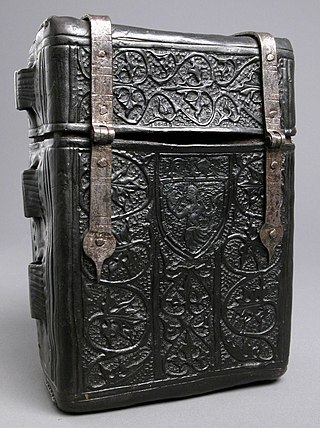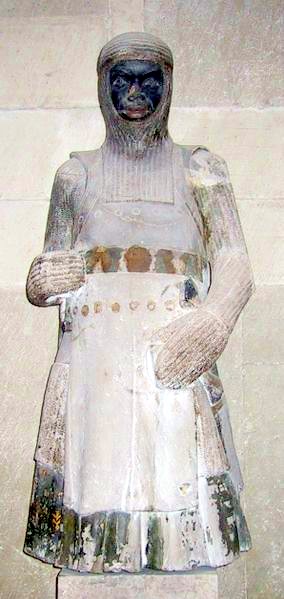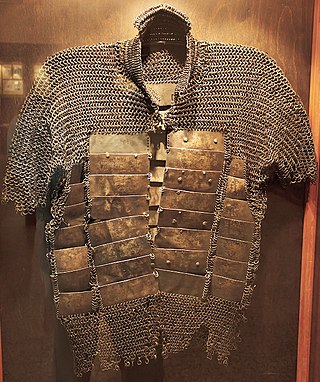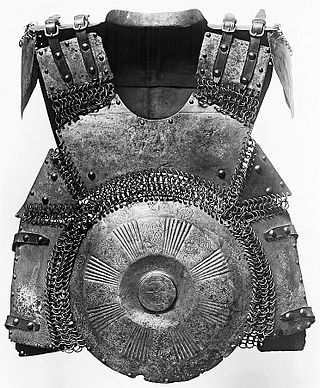
Armour or armor is a covering used to protect an object, individual, or vehicle from physical injury or damage, especially direct contact weapons or projectiles during combat, or from a potentially dangerous environment or activity. Personal armour is used to protect soldiers and war animals. Vehicle armour is used on warships, armoured fighting vehicles, and some combat aircraft, mostly ground attack aircraft.

Boiled leather, often referred to by its French translation, cuir bouilli, was a historical material common in the Middle Ages and Early Modern Period and used for various purposes. It was leather that had been treated so that it became tough and rigid, as well as able to hold moulded decoration. It was the usual material for the robust carrying-cases that were made for important pieces of metalwork, instruments such as astrolabes, personal sets of cutlery, books, pens and the like. It was used for some armour, being both much cheaper and much lighter than plate armour, but could not withstand a direct blow from a blade, nor a gunshot.

Chain mail is a type of armour consisting of small metal rings linked together in a pattern to form a mesh. It was in common military use between the 3rd century BC and the 16th century AD in Europe, while it continued to be used in Asia, Africa, and the Middle East as late as the 17th century. A coat of this armour is often called a hauberk or sometimes a byrnie.

A gambeson is a padded defensive jacket, worn as armour separately, or combined with mail or plate armour. Gambesons were produced with a sewing technique called quilting that produced a padded cloth. They were usually constructed of linen or wool; the stuffing varied, and could be, for example, scrap cloth or horse hair.

A cuirass is a piece of armour that covers the torso, formed of one or more pieces of metal or other rigid material. The word probably originates from the original material, leather, from the French cuirace and Latin word coriacea. The use of the term "cuirass" generally refers to both the breastplate and the backplate pieces; whereas a breastplate only protects the front, a cuirass protects both the front and the back of the wearer.

Plate armour is a historical type of personal body armour made from bronze, iron, or steel plates, culminating in the iconic suit of armour entirely encasing the wearer. Full plate steel armour developed in Europe during the Late Middle Ages, especially in the context of the Hundred Years' War, from the coat of plates worn over mail suits during the 14th century.

Lamellar armour is a type of body armour, made from small rectangular plates of iron or steel, leather (rawhide), bone, or bronze laced into horizontal rows. Lamellar armour was used over a wide range of time periods in Central Asia, Eastern Asia, Western Asia, and Eastern Europe. The earliest evidence for lamellar armour comes from sculpted artwork of the Neo-Assyrian Empire in the Near East.

White armour, or alwyte armour, was a form of plate armour worn in the Late Middle Ages characterized by full-body steel plate without a surcoat. Around 1420 the surcoat, or "coat of arms" as it was known in England, began to disappear, in favour of uncovered plate. Areas not covered by plate were protected by mail sewn to the gambeson underneath.

A gauntlet is a type of glove that protects the hand and wrist of a combatant. Gauntlets were used particularly in Europe between the early fourteenth century and the early modern period and were often constructed of hardened leather or metal plates.

A brigandine is a form of body armour from the late Middle Ages and up to the early Modern Era. It is a garment typically made of heavy cloth, canvas, or leather, lined internally with small oblong steel plates riveted to the fabric, sometimes with a second layer of fabric on the inside.

Chinese armour was predominantly lamellar from the Warring States period onward, prior to which animal parts such as rhinoceros hide, rawhide, and turtle shells were used for protection. Lamellar armour was supplemented by scale armour since the Warring States period or earlier. Partial plate armour was popular from the Eastern and Southern dynasties (420–589), and mail and mountain pattern armour from the Tang dynasty (618–907). Chain mail had been known since the Han dynasty, but did not see widespread production or battlefield use, and may have seen as "exotic foreign armor" used as a display of wealth for wealthier officers and soldiers. During the Ming dynasty (1368–1644), brigandine began to supplant lamellar armour and was used to a great degree into the Qing dynasty (1644–1912). By the 19th century most Qing armour, which was of the brigandine type, were purely ceremonial, having kept the outer studs for aesthetic purposes, and omitted the protective metal plates.

Chausses were a Medieval term for leggings, which was also used for leg armour; routinely made of mail and referred to as mail chausses. They generally extended well-above the knee, covering most of the leg. Mail chausses were the standard type of metal leg armour in Europe from the 11th to the 14th century. Chausses offered flexible protection that was effective against slashing weapons. However, the wearer still felt the full force of crushing blows.

Splint armour is armour consisting of strips of metal ("splints") attached to a cloth or leather backing. It is most commonly found as limb armour such as greaves or vambraces.

A coat of plates is a form of segmented torso armour consisting of overlapping metal plates riveted inside a cloth or leather garment. The coat of plates is considered part of the era of transitional armour and was normally worn as part of a full knightly harness. The coat saw its introduction in Europe among the warring elite in the 1180s or 1220s and was well established by the 1250s. It was in very common usage by the 1290s. By the 1350s it was universal among infantry militias as well. After about 1340, the plates covering the chest were combined to form an early breastplate, replacing the coat of plates. After 1370, the breastplate covered the entire torso. Different forms of the coat of plates, known as the brigandine and jack of plates, remained in use until the late 16th century.

Mail and plate armour is a type of mail with embedded plates. Armour of this type has been used in the Middle East, North Africa, Ottoman Empire, Japan, China, Korea, Vietnam, Central Asia, Greater Iran, India, Eastern Europe, and Nusantara.

Mirror armour, sometimes referred to as disc armour or as chahār-āyneh or char-aina, was a type of cuirass used mainly in Asia, the Middle East, and Eastern Europe; including India, Persia, Tibet, Russia, and the Ottoman Empire. It literally translates to "four mirrors" which is a reflection of how these pieces looked, which resembles four metal discs or rectangular armour plates. Mirror armor was used in some cultures up to the 20th century.

Scholars agree that Japanese armour first appeared in the 4th century, with the discovery of the cuirass and basic helmets in graves. During the Heian period (794-1185), the unique Japanese samurai armour ō-yoroi and dō-maru appeared. The Japanese cuirass evolved into the more familiar style of body armour worn by the samurai known as the dou or dō, with the use of leather straps (nerigawa), and lacquer for weatherproofing. Leather and/or iron scales were also used to construct samurai armours, with leather and eventually silk lace used to connect the individual scales (kozane) of these cuirasses.

Laminar armour is an armour made from horizontal overlapping rows or bands of, usually small, solid armour plates called lames, as opposed to lamellar armour, which is made from individual armour scales laced together to form a solid-looking strip of armour. Prominent examples of such armour are lorica segmentata of Ancient Rome and certain versions of samurai armour.

Tatami (畳具足), or tatami gusoku, was a type of lightweight portable folding Japanese armour worn during the feudal era of Japan by the samurai class and their foot soldiers (ashigaru). The Tatami dō or the tatami katabira were the main components of a full suit of tatami armour.
Vietnamese armour is military body armour made in the region of Vietnam.




















